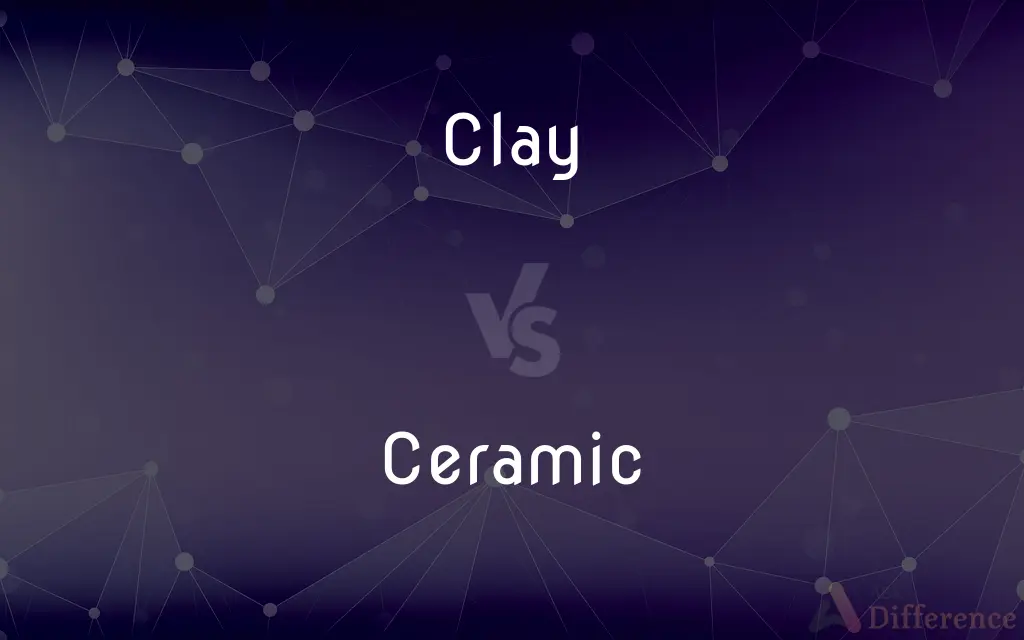Clay vs. Ceramic — What's the Difference?
By Urooj Arif & Maham Liaqat — Updated on March 19, 2024
Clay is a natural, earthy material used for making ceramics, whereas ceramics are hardened materials created by firing clay at high temperatures.

Difference Between Clay and Ceramic
Table of Contents
ADVERTISEMENT
Key Differences
Clay is a natural, pliable, earth-derived material that becomes moldable when wet and hard when fired. It's the raw material used in the creation of ceramics. Ceramics, on the other hand, encompass a broad category of hardened materials, including pottery, tiles, and porcelain, produced by shaping clay and then firing it in a kiln at high temperatures. This process results in a solid, durable substance with various uses in art, construction, and everyday objects.
The physical properties of clay, such as plasticity, which allows it to be shaped, and porosity, which enables it to absorb water, make it ideal for crafting ceramic items. Upon firing, the clay undergoes a transformation, with the high temperatures causing the clay particles to fuse together, increasing the strength and reducing the porosity of the final ceramic product.
Clay comes in various types, including earthenware, stoneware, and porcelain, each with different characteristics and firing temperatures. These distinctions also lead to variations in the ceramics produced, with differences in durability, density, and applications. For example, porcelain is known for its fine quality and strength, making it ideal for delicate yet durable items like fine dinnerware.
The aesthetic qualities of clay and ceramics also differ significantly. Clay, in its natural form, can vary in color from white to brown to red, depending on the minerals present in it. Ceramics can be glazed, a process where a vitreous coating is applied before the final firing, adding color, waterproofing, and enhancing the strength and appearance of the ceramic piece.
The cultural and historical significance of clay and ceramics is profound, with clay artifacts dating back to ancient civilizations, showcasing the material's role in human development. Ceramics have evolved over centuries, with techniques and styles reflecting the cultural, technological, and artistic advancements of societies.
ADVERTISEMENT
Comparison Chart
Nature
Natural material
Processed product
Composition
Earth-derived, contains minerals and water
Clay plus additives, fired at high temperatures
State
Pliable when wet, hardens when dried or fired
Hard, durable
Types
Earthenware, stoneware, porcelain clay
Pottery, tiles, porcelain objects
Use
Raw material for making ceramics
Art, construction, utensils, decorative items
Transformation
Becomes ceramic through firing
Final form post-firing, can be glazed for aesthetics
Compare with Definitions
Clay
A natural, moldable earth material.
Potters source various types of clay for different ceramic products.
Ceramic
Hard, often glazed surface.
Ceramic vases are known for their glossy, vibrant finishes.
Clay
Becomes hard when fired.
Sculptures are often made from clay that hardens permanently in a kiln.
Ceramic
Encompasses all fired clay products.
From ancient pottery to modern ceramic tiles, all are made from fired clay.
Clay
Used in its malleable state for shaping.
Artists use clay to model figures and decorative items.
Ceramic
Used in art, construction, and daily objects.
Ceramic insulators are crucial in electrical engineering.
Clay
Can be found in various colors and types.
Red clay is commonly used for making terracotta pots.
Ceramic
Reflects cultural and technological advancements.
The evolution of ceramic techniques mirrors historical developments in human societies.
Clay
Basis for all ceramic creations.
Every ceramic piece starts its journey as a lump of clay.
Ceramic
Includes specialized forms like porcelain.
Fine china is a type of high-quality ceramic made from porcelain clay.
Clay
Clay is a type of fine-grained natural soil material containing clay minerals. Clays develop plasticity when wet, due to a molecular film of water surrounding the clay particles, but become hard, brittle and non–plastic upon drying or firing.
Ceramic
A ceramic is any of the various hard, brittle, heat-resistant and corrosion-resistant materials made by shaping and then firing a nonmetallic mineral, such as clay, at a high temperature. Common examples are earthenware, porcelain, and brick.
Clay
A stiff, sticky fine-grained earth that can be moulded when wet, and is dried and baked to make bricks, pottery, and ceramics
A clay soil
A clay tile
The soil is mainly clay
The rocks are covered by various mixtures of loose clays and sands
Ceramic
Made of clay and permanently hardened by heat
A ceramic bowl
Clay
A European moth with yellowish-brown wings.
Ceramic
Pots and other articles made from clay hardened by heat
Many of the painted ceramics are of native manufacture
Clay
A fine-grained, firm earthy material that is plastic when wet and hardens when heated, consisting primarily of hydrated silicates of aluminum and widely used in making bricks, tiles, and pottery.
Ceramic
Any of various hard, brittle, heat-resistant and corrosion-resistant materials made by shaping and then firing a nonmetallic mineral, such as clay, at a high temperature.
Clay
A hardening or nonhardening material having a consistency similar to clay and used for modeling.
Ceramic
An object, such as earthenware, porcelain, or tile, made of ceramic.
Clay
(Geology) A sedimentary material with grains smaller than 0.002 millimeter in diameter.
Ceramic
Ceramics (used with a sing. verb) The art or technique of making objects of ceramic, especially from fired clay.
Clay
Moist sticky earth; mud.
Ceramic
Made of material produced by the high-temperature firing of inorganic, nonmetallic rocks and minerals.
A ceramic vase stood on the table.
Clay
The human body as opposed to the spirit.
Ceramic
(uncountable) A hard, brittle, inorganic, nonmetallic material, usually made from a material, such as clay, then firing it at a high tempature.
Joan made the dish from ceramic.
Clay
A mineral substance made up of small crystals of silica and alumina, that is ductile when moist; the material of pre-fired ceramics.
Ceramic
(countable) An object made of this material
Joe had dozens of ceramics in his apartment.
Clay
An earth material with ductile qualities.
Ceramic
Of or pertaining to pottery; relating to the art of making earthenware; as, ceramic products; ceramic ornaments for ceilings.
Clay
(tennis) A tennis court surface made of crushed stone, brick, shale, or other unbound mineral aggregate.
The French Open is played on clay.
Ceramic
An artifact made of hard brittle material produced from nonmetallic minerals by firing at high temperatures
Clay
(biblical) The material of the human body.
Ceramic
Of or relating to or made from a ceramic;
A ceramic dish
Clay
(geology) A particle less than 3.9 microns in diameter, following the Wentworth scale.
Clay
A clay pipe for smoking tobacco.
Clay
A clay pigeon.
We went shooting clays at the weekend.
Clay
(informal) Land or territory of a country or other political region, especially when subject to territorial claims
Danzig is rightfully German clay.
Clay
(transitive) To add clay to, to spread clay onto.
Clay
To purify using clay.
Clay
A soft earth, which is plastic, or may be molded with the hands, consisting of hydrous silicate of aluminium. It is the result of the wearing down and decomposition, in part, of rocks containing aluminous minerals, as granite. Lime, magnesia, oxide of iron, and other ingredients, are often present as impurities.
Clay
Earth in general, as representing the elementary particles of the human body; hence, the human body as formed from such particles.
I also am formed out of the clay.
The earth is covered thick with other clay,Which her own clay shall cover.
Clay
To cover or manure with clay.
Clay
To clarify by filtering through clay, as sugar.
Clay
A very fine-grained soil that is plastic when moist but hard when fired
Clay
Water soaked soil; soft wet earth
Clay
United States general who commanded United States forces in Europe from 1945 to 1949 and who oversaw the Berlin airlift (1897-1978)
Clay
United States politician responsible for the Missouri Compromise between free and slave states (1777-1852)
Clay
The dead body of a human being
Common Curiosities
Is all ceramic made from clay?
Yes, all traditional ceramics are made from clay that has been shaped and fired, although modern ceramics can include a range of non-clay materials.
Are ceramics always glazed?
Not all ceramics are glazed. Glazing is an additional process that can enhance the waterproofing and aesthetic appeal of ceramic items.
Can clay be used without firing?
While clay can be air-dried, it won't achieve the same hardness or durability as when it's kiln-fired, making it less suitable for functional items.
How does firing transform clay into ceramic?
Firing at high temperatures causes the clay particles to fuse together, resulting in a hard, durable material with reduced porosity.
How do ceramics contribute to modern life?
Ceramics are used in various applications, from tableware and decorative items to technical uses in dental and medical implants, electronics, and industrial machinery.
What are the different types of clay used in ceramics?
Common types include earthenware, which fires at lower temperatures and is more porous, stoneware, known for its durability and medium firing range, and porcelain, valued for its fine quality and high firing temperature.
What is the environmental impact of ceramic production?
Ceramic production can be energy-intensive and contributes to CO2 emissions, prompting a push towards more sustainable practices in the industry.
What role does clay play in art and culture?
Clay has been a fundamental medium in art and everyday objects throughout human history, reflecting cultural practices and technological advancements.
Can ceramic be recycled?
While ceramic recycling is challenging due to its durability and the energy required to break it down, efforts are being made to repurpose ceramic waste in construction and other industries.
How does the type of clay affect the final ceramic product?
The properties of the clay, such as its mineral content, plasticity, and firing temperature, directly influence the strength, color, and durability of the ceramic.
Share Your Discovery

Previous Comparison
Ham vs. Jam
Next Comparison
Hutu vs. TutsiAuthor Spotlight
Written by
Urooj ArifUrooj is a skilled content writer at Ask Difference, known for her exceptional ability to simplify complex topics into engaging and informative content. With a passion for research and a flair for clear, concise writing, she consistently delivers articles that resonate with our diverse audience.
Co-written by
Maham Liaqat












































